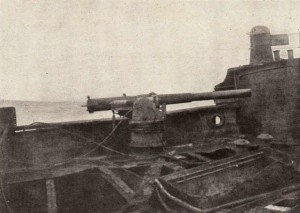On Christmas day, 1916 a Norwegian clipper ship, the Irma, was boarded by the British cruiser, Avenger. There was nothing particularly unusual, the captain spoke the broken English of an old Norwegian salt, the entire ship was damp from the past four days of heavy rains, and the captain’s wife sat in the cabin, with a toothache. The British officers combed through every piece of paper, found everything in order, and then returned to their cruiser, telling the Norwegians to continue on their voyage.
But the Irma didn’t exist. In truth, she was the SMS Seeadler, a German auxiliary cruiser destined to hunt British shipping. The Captain’s wife was a German sailor in a dress and wig. And the captain himself was Count Felix von Luckner, the rakish and sea loving German naval officer.
(Count Felix von Luckner)
Von Luckner was born in Dresden in 1881, son to Count Heinrich von Luckner. The von Luckner family had made a name for themselves, 100 years earlier, as expert cavalry officers. Felix’s great-grandfather, Nicolas Von Luckner, had formed his own cavalry unit, and fought notably throughout the Napoleonic wars, eventually being awarded the title of Marshal of France. With this pedigree, it is understandable how confused Heinrich von Luckner must have been when his ill-behaved son told him he wanted to put to sea.
(Felix von Luckner’s great-grandfather, Nicolas Luckner, who earned the title of Marshal of France)
Felix had always been a terrible student and often got into fights during his schooling. His parents got more and more upset with him until at the age of 13 he ran from home and headed out to sea. His sailing career began with the worst voyage of his life, on board a Russian freighter. Often beaten and forced to clean the pigsty Felix vowed that his life would improve, and he would return home as an Officer in the Imperial German Navy.
He pursued many different careers while abroad, from lighthouse keeper to Kangaroo hunter. The former failed when he was caught courting the lighthouse master’s daughter, and the latter when he realized he had little idea how to hunt. Finally, he made it back to Germany and earned the right to be a Naval Officer, quickly rising through the ranks, thanks in part to favor from the Kaiser himself.
By 1916 von Luckner was a Kapitan Leutnant, and was selected to lead a special mission. The German Admiralty had a number of sailing ships in their possession and wanted to use them to break through the British blockade which had been starving the nation since 1914. Von Luckner was the only German officer who had actual sailing experience, and he eagerly agreed to take the position. The Seeadler, originally the Pass of Balmaha, was heavily refitted, with trapdoors, hiding places, and secret rooms. This was all designed to confuse, trap, or sneak past any British boarding party or prize crew. She set sail on the 21st of December, 1916.
(The Pass of Balmaha, the Windjammer destined to become one of the most famous commerce raiders in modern history)
Her crew was selected for both sailing ability, and fluency in Norwegian, she posed as the make-believe ship the Irma, claiming to be transporting lumber to Australia. As explained earlier, on its first try the clever ruse worked. The crew was ready and excited to play pirate; they sailed south to hunt for British ships.
They didn’t have to travel long before they came across an unnamed steamship, which looked of British build, and bore no name, a sure sign that she was English. The Seeadler asked her for the time, and as the ship slowed down to answer, the German crew dropped their Norwegian flag, and hoisted up the German Battle Ensign. A section of her deck railing popped open, revealing a cannon which fired a warning shot across the English bow. After three more shots the British captain came on board, completely bewildered as to what had just happened. He had been steaming lazily along, bound for a neutral port, and all of a sudden an old sailing ship had committed an act of war against his ship. These tactics would earn the Seeadler’s crew the nickname “Piraten des Kaisers” (The Kaiser’s Pirates).
(The Charles Gounod, one of the 15 ships the Kaiser’s Pirates captured during their 255-day cruise of the Atlantic and Pacific)
Over the next few months, the crew of the Seeadler wreaked havoc on British shipping in the Atlantic, capturing and sinking 15 ships. But there was a code of conduct among this buccaneering crew of piratical sailors: fight a war without death. When capturing a vessel, they would ensure that the entire crew had offloaded before sinking her. And even sinking a vessel was a somber experience, these men were sailors through and through, and knew that a ship was a man’s home, not just a piece of metal or wood. Every capture was as different as every ship on the sea, but one stood out as their true test of skill.
On March 11th, 1917 the British steamer Horngarth came into the Seeadler’s view. She was over 3,600 tons, fast, and ready for a fight. On her forward deck stood a 5-inch cannon, which could completely destroy the Germans in their old sailing ship. To make matters worse, she had a radio set on board, which could transmit a distress call, and her position, to the rest of the British fleet, easily spelling the end for the Seeadler.
(A painting of SMS Seeadler under full sail in the Atlantic. Her unassuming appearing as just another sailing ship allowed her to fool other ships into coming in close enough to be boarded and captured)
Horngarth clearly outmatched the German vessel, but von Luckner was not deterred. He signaled her as usual, asking for the time. She ignored him; something not uncommon among British steamers. But the Seeadler had another trick up her sleeve. They had rigged the galley house to appear as if it was on fire. Using a piece of magnesium and smoke, they set a fake fire in the center of the ship. The crew rushed about looking like they were putting it out, while the sailor Schmitt, came out playing the role of the captain’s wife Josefina again.
The British ship came closer to render aid, but as they drew near the scene in front of them completely changed. On von Luckner’s order, the German battle flag was run up the flagstaff, the fire was doused, and the riflemen who had been hiding under the ship’s rail popped up. Josefina threw off her dress and wig, and the sailor Schmitt reappeared, rushing to his station. Again, the deck rail dropped, revealing their cannon. A shot roared from the German ship, knocking out the radio antenna. The riflemen kept their weapons trained on the British 5-inch cannon, ready to shoot any sailor who approached it.
(One of the two hidden cannons onboard the Seeadler. You can see the section of deck railing which would pop down, allowing the gun full movement, while concealing it when not in use. This ingenuity allowed them to appear and non-threatening as possible, until the very last moment when the entire crew would strike their target)
The British crew ran about in utter confusion, they, like the ships before them, were bewildered by the sudden change from Norwegian sailing ship, to German cruiser in the blink of an eye. But the captain was able to calm his men until a terrifying sound came from Seeadler’s bow. Von Luckner had position three men with speaking trumpets on the bowsprit, who had been waiting for the signal to act. They then roared out in English “torpedoes clear!”.
The British faces turned white, and suddenly the whole ship surrendered, not wanting to face the possibility of a torpedoing. Of course, Seeadler had no means for firing a torpedo, but the bluff worked, and they captured their largest prize, without a single death.
(The eventual wreck of the Seeadler. The crew destroyed her after taking all materials and provisions they could)
But the reputation of the Kaiser’s Pirates had gotten ahead of them, and they were pursued by American and British cruisers. Chased around Cape Horn, she found herself in the Pacific. She ran aground at Mopelia, a coral atoll, and the crew established a German colony there. Later Von Luckner attempted to escape, stealing a speedboat, and later a schooner, but was captured by the New Zealand ship Iris. The rest of the crew captured the French schooner Lutece and sailed it into Chilean waters.
There they were captured by the authorities and held in an internment camp until 1919. Von Luckner and his buccaneer crew returned to Germany as heroes, and their exploits have gone down in history as the stuff of legend and myth. The age of military sail ended with the adoption of steam in the 1800s, but the Seeadler and the Piraten des Kaisers proved that sailing ships wouldn’t go down without a fight.
Ask me anything
Explore related questions












